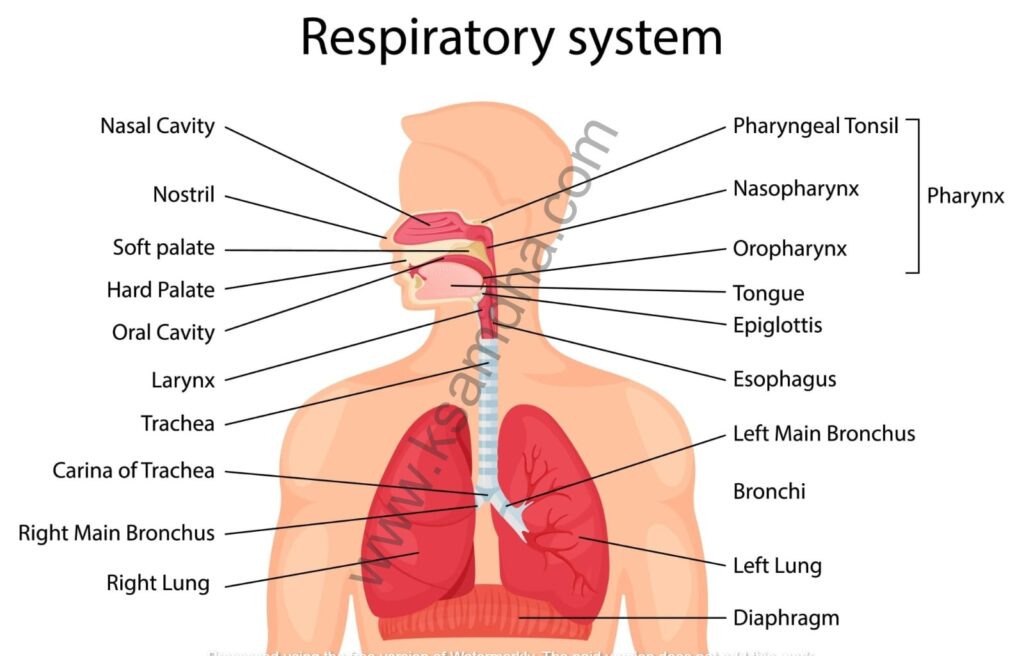What is Respiratory System
The respiratory system is the biological system in the human body (and in other animals) that allows breathing. Its main job is to take in oxygen from the air and remove carbon dioxide from the body. This process is essential because oxygen is needed by every cell to produce energy, and carbon dioxide (a waste product) must be expelled to keep the body balanced.
The respiratory system is the system in the human body responsible for breathing. Its main function is to supply oxygen (O₂) to the blood and remove carbon dioxide (CO₂), a waste product of metabolism. This system works closely with the circulatory system to deliver oxygen to cells and remove waste gases.

Main Functions of the Respiratory System:
- Breathing (Ventilation): Inhaling oxygen-rich air and exhaling carbon dioxide.
- Gas Exchange: Oxygen enters the blood, and carbon dioxide leaves it (mainly in the lungs).
- Transport of Gases: Oxygen travels from lungs → blood → body tissues; carbon dioxide travels back to lungs.
- Sound Production: The larynx (voice box) helps in speaking.
- Smell (Olfaction): The nose contains receptors for detecting odors.
- Protection: Filters out dust, microbes, and harmful substances with mucus and cilia.
Major Organs of the Respiratory System:
- Nose and Nasal Cavity: First entry point for air; filters, warms, and moistens air.
- Pharynx (Throat): Passageway for air and food.
- Larynx (Voice Box): Produces sound and protects the airway.
- Trachea (Windpipe): Carries air to the lungs.
- Bronchi and Bronchioles: Branching tubes that distribute air inside the lungs.
- Lungs: Main organs where oxygen enters the blood and carbon dioxide leaves.
- Alveoli: Tiny air sacs in the lungs where gas exchange happens.
- Diaphragm: Muscle that helps in breathing by expanding and contracting the chest cavity.
⚙️ Process of Breathing
- Inhalation (Inspiration):
- Diaphragm contracts and moves downward.
- Chest cavity expands, lungs fill with air.
- Oxygen enters alveoli and diffuses into blood.
- Exhalation (Expiration):
- Diaphragm relaxes and moves upward.
- Chest cavity reduces in size, air is pushed out.
- Carbon dioxide exits the body.
🧠 Control of Respiration
- Controlled by the medulla oblongata and pons in the brainstem.
- Chemoreceptors in the body sense CO₂ and O₂ levels to adjust breathing rate.
list of respiratory system diseases grouped into major categories for clarity:
🔹 Upper Respiratory Tract Diseases
- Common Cold (Acute viral rhinitis)
- Sinusitis
- Pharyngitis
- Tonsillitis
- Laryngitis
- Epiglottitis
- Influenza
🔹 Lower Respiratory Tract Diseases
- Acute Bronchitis
- Chronic Bronchitis (part of COPD)
- Bronchiolitis (common in children)
- Pneumonia (bacterial, viral, fungal, aspiration)
- Tuberculosis (TB)
- Pertussis (Whooping cough)
🔹 Obstructive Lung Diseases
- Asthma
- Chronic Obstructive Pulmonary Disease (COPD)
- Chronic bronchitis
- Emphysema
- Bronchiectasis
- Cystic Fibrosis
🔹 Restrictive Lung Diseases
- Pulmonary Fibrosis (Idiopathic Pulmonary Fibrosis – IPF)
- Pneumoconiosis (e.g., Asbestosis, Silicosis, Coal Worker’s Pneumoconiosis)
- Sarcoidosis
🔹 Vascular / Circulatory Respiratory Diseases
- Pulmonary Embolism (PE)
- Pulmonary Hypertension
- Pulmonary Edema
🔹 Respiratory Infections
- COVID-19 (Coronavirus disease)
- Severe Acute Respiratory Syndrome (SARS)
- Middle East Respiratory Syndrome (MERS)
- Respiratory Syncytial Virus (RSV) infection
- Hantavirus Pulmonary Syndrome
🔹 Pleural Diseases
- Pleurisy (Pleuritis)
- Pleural Effusion
- Pneumothorax (Collapsed lung)
- Hemothorax
🔹 Respiratory Cancers
- Lung Cancer (Small cell lung cancer, Non-small cell lung cancer)
- Mesothelioma (pleural cancer)
- Laryngeal Cancer
- Nasopharyngeal Cancer
🔹 Sleep-Related Respiratory Disorders
- Obstructive Sleep Apnea (OSA)
- Central Sleep Apnea
- Hypoventilation Syndrome
🔹 Other Respiratory Disorders
- Acute Respiratory Distress Syndrome (ARDS)
- Respiratory Failure (acute / chronic)
- Occupational lung diseases (e.g., Farmer’s lung, Byssinosis)
- Hypersensitivity Pneumonitis
- Bronchopulmonary Dysplasia (common in premature infants)
Neonatal Respiratory Diseases/disorders:
- Respiratory Distress Syndromes (RDS)
- Hyaline membrane disease (classic neonatal RDS – due to surfactant deficiency)
- Transient tachypnea of the newborn (TTN)
- Meconium aspiration syndrome (MAS)
- Persistent pulmonary hypertension of the newborn (PPHN)
- Infections
- Neonatal pneumonia (bacterial, viral, fungal)
- Congenital pneumonia (Group B streptococcus, E. coli, Listeria, etc.)
- Sepsis with respiratory involvement
- Airway & Lung Malformations
- Congenital diaphragmatic hernia (CDH)
- Congenital lobar emphysema
- Pulmonary hypoplasia
- Bronchopulmonary sequestration
- Tracheoesophageal fistula (TEF) with esophageal atresia
- Laryngeal web or stenosis
- Choanal atresia
- Chronic Lung Diseases
- Bronchopulmonary dysplasia (BPD) (common in preterm infants after prolonged ventilation/O₂ therapy)
- Other Causes of Neonatal Respiratory Distress
- Pneumothorax / pneumomediastinum
- Pulmonary hemorrhage
- Aspiration pneumonia (milk or blood)
- Upper airway obstruction (tongue, micrognathia, Pierre Robin sequence)
- Hypoventilation syndromes (e.g., congenital central hypoventilation syndrome)
